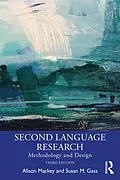Second Language Research: Methodology and Design is a clear, comprehensive overview of core issues in L2 research. Authored by well-known scholars in SLA and supported by a wealth of examples from actual studies and extensive pedagogical resources, this book first introduces students to the key topics and debates in L2 research. It then guides readers step by step through the research process-from basic principles and collection methods through study design and reporting-to the point of being able to conduct their own research from beginning to end. This book is an essential text for students and novice researchers of SLA, applied linguistics, and second and foreign language teaching.
Key Features
- A wealth of graphics, visuals, and exercises in each chapter.
- "Time to Think" and "Time to Do" boxes within chapters
- Helpful glossary and subject index
New to This Edition
- Substantially reorganized chapters
- Significantly expanded chapters on qualitative and mixed methods
- Substantive revised material on computer/technology-based research
- Spotlights a variety of new software packages and databases, including video-mediated technology and games
- Discusses the Open Science Movement
- Expanded coverage of corpora, processing, and psycholinguistics-based research
- Updated references throughout
- A wealth of graphics, visuals, and exercises in each chapter.
- "Time to Think" and "Time to Do" boxes within chapters
- Helpful glossary and subject index
- Substantially reorganized chapters
- Significantly expanded chapters on qualitative and mixed methods
- Substantive revised material on computer/technology-based research
- Spotlights a variety of new software packages and databases, including video-mediated technology and games
- Discusses the Open Science Movement
- Expanded coverage of corpora, processing, and psycholinguistics-based research
- Updated references throughout
Autorentext
Alison Mackey is Professor and Chair of the Department of Linguistics at Georgetown University, USA.
Susan M. Gass is University Distinguished Professor Emerita in Second Language Studies at Michigan State University, USA.
Klappentext
Second Language Research: Methodology and Design is a clear, comprehensive overview of core issues in L2 research. Authored by well-known scholars in SLA and supported by a wealth of examples from actual studies and extensive pedagogical resources, this book first introduces students to the key topics and debates in L2 research. It then guides readers step by step through the research process-from basic principles and collection methods through study design and reporting-to the point of being able to conduct their own research from beginning to end. This book is an essential text for students and novice researchers of SLA, applied linguistics, and second and foreign language teaching.
Key Features
New to This Edition
Inhalt
Contents
Preface
1.
Introduction to Research
1.1
Research Methods
1.2
Different Types of Research
1.3
Ethical Practices
1.3.1
Informed Consent
1.3.1.1
Sufficient Information
1.3.1.2
The Informed Consent Document
1.3.1.3
Participant Comprehension in Informed Consent
1.3.1.4
The Language of Informed Consent
1.3.1.5
Voluntary Participation and Informed Consent
1.3.2
Child Second Language Learners
1.3.3
Issues Involved in Collecting Data Online
1.3.4
WEIRD Populations
1.3.5
Reporting and Anonymity
1.4
Institutional Review of Human Participants Research, Compliance, and Problem-Solving
1.4.1
Purpose of Reviews and IRB Responsibilities
1.4.2
Why Guidelines to Protect Human Subjects Were Developed
1.4.3
Development of Research Codes of Ethics
1.4.4
Preparing a Protocol for the IRB
1.4.5
General Use of Protocols in Research
1.5
Conclusion
Points to Remember
More to Do and More to Think About ...
Sample Responses: Time to Think & Time to Do
Sample Responses: More to Do and More to Think About...
2.
Research Reporting, Research Questions, and Replication
2.1
What Does a Research Report Look Like?
2.1.1
Quantitative Reporting
2.1.1.1
Title Page
2.1.1.2
Abstract
2.1.1.3
Introduction
2.1.1.4
Historical Overview
2.1.1.5
Major Players in this Research Area, Including Questions, Past Findings, and Controversies
2.1.1.6
General Goal of the Paper
2.1.1.7
Research Questions/Hypotheses
2.1.1.8
Methods Section
2.1.1.9
Participants
2.1.1.10
Materials
2.1.1.11
Procedures
2.1.1.12
Analysis
2.1.1.13
Results
2.1.1.14
Discussion/Conclusion
2.1.1.15
Notes
2.1.1.16
References
2.1.1.17
Appendices
2.1.2
Qualitative Reporting
2.1.3
Mixed-Method Reporting
2.2
Identifying Research Questions
2.2.1
Feasibility
2.2.2
Research Questions and Hypotheses
2.3
Replication
2.4
Conclusion
Points to Remember
More to Do and More to Think About ...
Sample Responses: Time to Think & Time to Do
Sample Responses: More to Do and More to Think About...
3.
Common Data Collection Measures
3.1
Introduction
3.2
The Significance of Data Collection Measures
3.3
